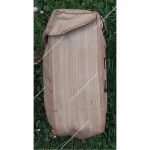Pouch, Basic (Large)

General Information
Name: Pouch, Basic (Large).
Country of Origin: Australia.
Equipment Family: 37-Pattern Web Equipment.
Colour: Khaki Tan.
Number Of compartments: One.
Waterproof: No.
For more specific details such as date of manufacture, manufacturer, size, volume capacity, and weight, see individual examples.
History
In early 1942, Australia recognized the need to redesign the 1937 Pattern web equipment based on combat experience in the Pacific against Japanese forces. The standard Basic Pouches were found to be too small to carry sufficient amounts of ammunition and munitions for the challenging conditions of jungle warfare.
To address this, the Basic Pouches were produced in the same heavyweight woven cotton webbing but redesigned to be wider and slightly taller. This adjustment allowed them to carry larger ammunition loads or extra rations. Additionally, a second variation was produced using an economy-grade canvas, which was considerably lighter but less durable. These redesigned “Large Basic Pouches” saw limited distribution during World War II, as the conflict ended before they could be issued in significant numbers.
However, they gained prominence during the Korean War and proved especially valuable during the Vietnam War. Dyed green for jungle operations, these pouches served as temporary replacements for the U.S. M-1956 Load-Carrying Equipment (LCE) Ammunition Pouch. Australian soldiers found the M-1956 pouches too small for their style of patrolling, making the Large Basic Pouch a preferred alternative.
In their original issued form, the pouches sat too high on the M-1956 web belt, and the shoulder strap support buckle was incompatible with the M-1956 web suspenders. To address these shortcomings, soldiers in the field modified them by adding holes at the top of the pouch to thread a web belt through or by attaching M-1956 metal side keepers higher up the back. These adjustments allowed the pouch to sit lower on the web belt for improved accessibility and comfort.
By the mid-1970s, the Enlarged Basic Pouch was officially removed from service and sold through surplus stores. Despite its withdrawal, the pouch maintained its popularity for private purchase. On occasion, soldiers could still be seen using these pouches, often retrofitted with modern closures and belt attachments to repurpose them as utility pouches.
Description
The Pouch, Basic (Large) is fabricated from woven cotton webbing. It is constructed using two grades of webbing: a lighter-weight webbing on the front and a heavier-grade webbing on the sides, bottom, and back.
The pouch has a permanently attached lid that folds over the top, with extended sides and front panels to help prevent items from falling out.
On the back, two double hooks (C-hooks) are sewn into the middle. At the top, a webbing tab extends above the pouch and holds a 37-Pattern brass buckle, designed for threading the 37-Pattern web suspenders. Between this tab and the pouch is a sleeve through which the excess webbing strap from the suspenders is threaded.
Internally, the pouch is reinforced at the lower front to compensate for the lighter-weight webbing used on the front panel.
Examples
Example One
Manufacturer: Yet to be identified.
Date of manufacture: c 1943.
Volume Capacity: 4L.
Size:
Height-21cm.
Width- 9cm.
Length-17cm.
Weight: 500g.
Example Two
Below is an example of the economy-grade canvas variation of the Large Basic Pouch. Lighter but less durable than the standard webbing version, these pouches were produced late in the war and saw limited distribution.
Manufacturer: Manufacturer: yet to be identified.
Date of manufacture: 1944.
Volume Capacity: 4L.
Size:
Height- 23cm.
Width- 8cm.
Length- 16cm.
Weight: 400g.







